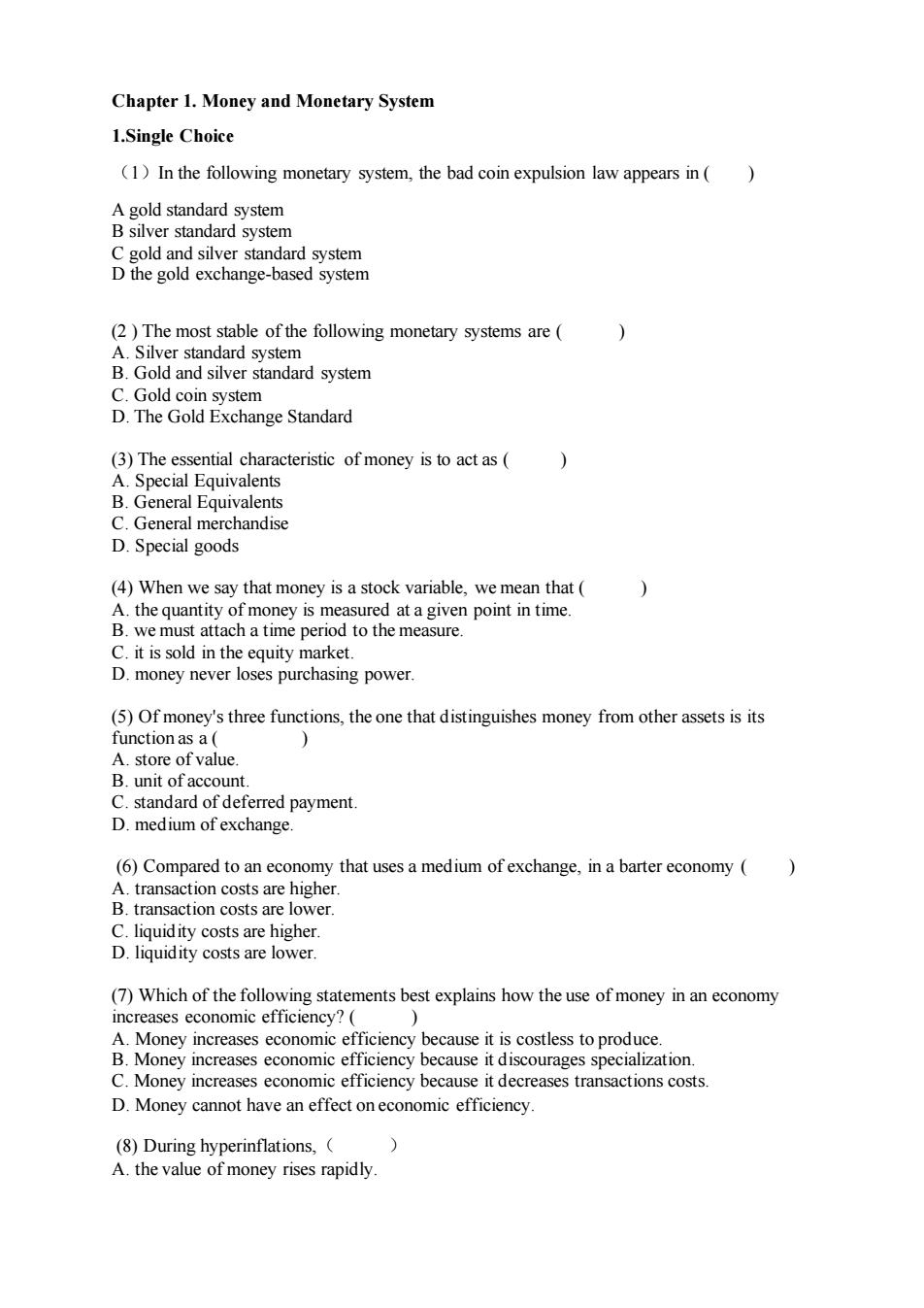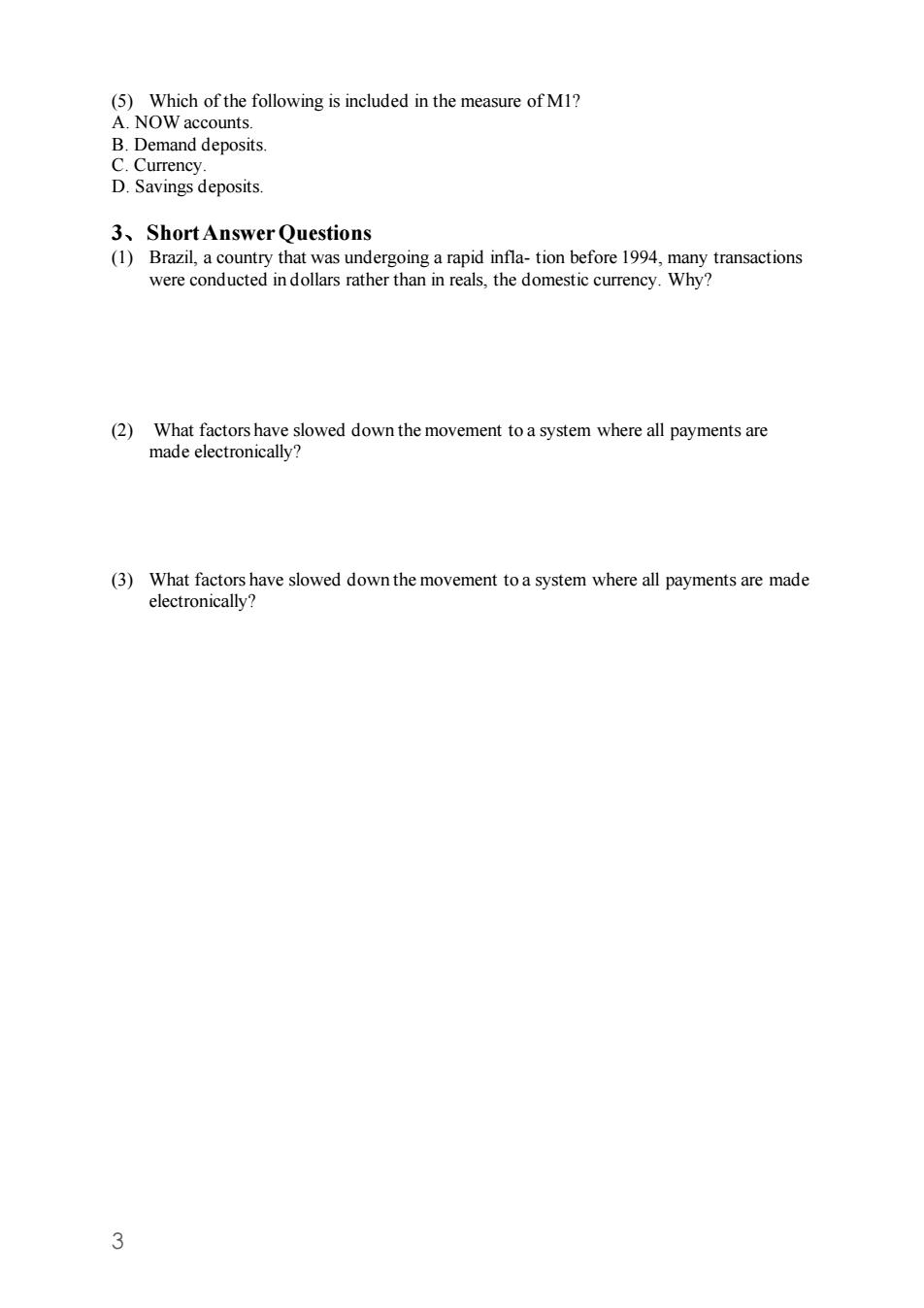
Chapter 1.Money and Monetary System 1.Single Choice (1)In the following monetary system,the bad coin expulsion law appears in ( A gold standard system B silver standard system C gold and silver standard system D the gold exchange-based system (2)The most stable of the following monetary systems are A.Silver standard system B.Gold and silver standard system C.Gold coin system D.The Gold Exchange Standard (3)The essential characteristic of money is to act as A.Special Equivalents B.General Equivalents C.General merchandise D.Special goods (4)When we say that money is a stock variable,we mean that A.the quantity of money is measured at a given point in time. B.we must attach a time period to the measure. C.it is sold in the equity market. D.money never loses purchasing power. (5)Of money's three functions,the one that distinguishes money from other assets is its function as a( A.store of value. B.unit of account C.standard of deferred payment. D.medium of exchange (6)Compared to an economy that uses a medium of exchange,in a barter economy ( A.transaction costs are higher. B.transaction costs are lower. C.liquidity costs are higher. D.liquidity costs are lower. (7)Which of the following statements best explains how the use of money in an economy increases economic efficiency?() A.Money increases economic efficiency because it is costless to produce. B.Money increases economic efficiency because it discourages specialization. C.Money increases economic efficiency because it decreases transactions costs. D.Money cannot have an effect on economic efficiency. (8)During hyperinflations, A.the value of money rises rapidly
Chapter 1. Money and Monetary System 1.Single Choice (1)In the following monetary system, the bad coin expulsion law appears in ( ) A gold standard system B silver standard system C gold and silver standard system D the gold exchange-based system (2 ) The most stable of the following monetary systems are ( ) A. Silver standard system B. Gold and silver standard system C. Gold coin system D. The Gold Exchange Standard (3) The essential characteristic of money is to act as ( ) A. Special Equivalents B. General Equivalents C. General merchandise D. Special goods (4) When we say that money is a stock variable, we mean that ( ) A. the quantity of money is measured at a given point in time. B. we must attach a time period to the measure. C. it is sold in the equity market. D. money never loses purchasing power. (5) Of money's three functions, the one that distinguishes money from other assets is its function as a ( ) A. store of value. B. unit of account. C. standard of deferred payment. D. medium of exchange. (6) Compared to an economy that uses a medium of exchange, in a barter economy ( ) A. transaction costs are higher. B. transaction costs are lower. C. liquidity costs are higher. D. liquidity costs are lower. (7) Which of the following statements best explains how the use of money in an economy increases economic efficiency? ( ) A. Money increases economic efficiency because it is costless to produce. B. Money increases economic efficiency because it discourages specialization. C. Money increases economic efficiency because it decreases transactions costs. D. Money cannot have an effect on economic efficiency. (8) During hyperinflations,( ) A. the value of money rises rapidly

B.money no longer functions as a good store of value and people may resort to barter transactions on a much larger scale. C.middle-class savers benefit as prices rise. D.money's value remains fixed to the price level;that is,if prices double so does the value of money. (9)Introduction of checks into the payments system reduced the costs of exchanging goods and services.Another advantage of checks is that A.they provide convenient receipts for purchases. B.they can never be stolen. C.they are more widely accepted than currency. D.the funds from a deposited check are available for use immediately. (10)Which of the following is included in M2 but not in M1? A.NOW accounts B.Demand deposits C.Currency D.Money market mutual fund shares(retail) 2.Multiple Choice (1)Which of the following is a FALSE statement?( ) A.Money and income are flow variables. B.Money is a flow variable. C.Income is a flow variable. D.Money and income are stock variables. (2)For a commodity to function effectively as money it should NOT be:( A.easily standard ized,making it easy to ascertain its value. B.difficult to make change. C.deteriorate quickly so that its supply does not become too large. D.hard to carry around. (3)As a store of value,money A.earn interest. B.can be a durable asset. C.must be currency. D.is a way of saving for future purchases (4)Increasing transactions costs of selling an asset make the asset A.less valuable B.more liquid. C.less liquid. D.less moneylike 2
2 B. money no longer functions as a good store of value and people may resort to barter transactions on a much larger scale. C. middle-class savers benefit as prices rise. D. money's value remains fixed to the price level; that is, if prices double so does the value of money. (9) Introduction of checks into the payments system reduced the costs of exchanging goods and services. Another advantage of checks is that A. they provide convenient receipts for purchases. B. they can never be stolen. C. they are more widely accepted than currency. D. the funds from a deposited check are available for use immediately. (10) Which of the following is included in M2 but not in M1? A. NOW accounts B. Demand deposits C. Currency D. Money market mutual fund shares (retail) 2. Multiple Choice (1) Which of the following is a FALSE statement?( ) A. Money and income are flow variables. B. Money is a flow variable. C. Income is a flow variable. D. Money and income are stock variables. (2) For a commodity to function effectively as money it should NOT be:( ) A. easily standardized, making it easy to ascertain its value. B. difficult to make change. C. deteriorate quickly so that its supply does not become too large. D. hard to carry around. (3) As a store of value, money A. earn interest. B. can be a durable asset. C. must be currency. D. is a way of saving for future purchases. (4) Increasing transactions costs of selling an asset make the asset A. less valuable. B. more liquid. C. less liquid. D. less moneylike

(5)Which of the following is included in the measure of M1? A.NOW accounts. B.Demand deposits. C.Currency. D.Savings deposits. 3,Short Answer Questions (1)Brazil,a country that was undergoing a rapid infla-tion before 1994,many transactions were conducted in dollars rather than in reals,the domestic currency.Why? (2)What factors have slowed down the movement to a system where all payments are made electronically? (3)What factors have slowed down the movement to a system where all payments are made electronically? 3
3 (5) Which of the following is included in the measure of M1? A. NOW accounts. B. Demand deposits. C. Currency. D. Savings deposits. 3、Short Answer Questions (1) Brazil, a country that was undergoing a rapid infla- tion before 1994, many transactions were conducted in dollars rather than in reals, the domestic currency. Why? (2) What factors have slowed down the movement to a system where all payments are made electronically? (3) What factors have slowed down the movement to a system where all payments are made electronically?